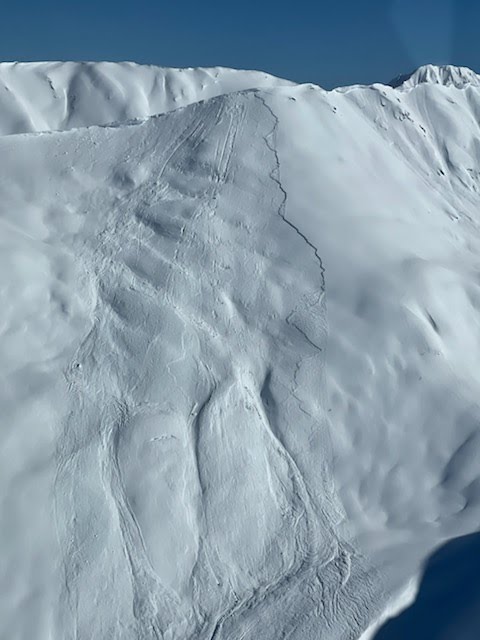After a beautiful and clear day in the mountains yesterday we are transitioning back to stormier weather today, with snow showers possible and increasing wind. The wind is coming ahead of the precipitation for this storm which could be exactly what we need to help knock down a new layer of surface hoar that formed on top of a thin melt freeze crust above 1500′ in Turnagain Pass. Wind speeds are expected to be 15-30 mph today with gusts possible up to 50 mph. We observed that thin, breakable melt freeze crust on all aspects up to our high point at 3000′ yesterday which should limit the amount of snow available for transport. Somehow the wind always seems to find snow to move around, so wind slabs up to a foot deep are still the most likely avalanche to trigger today. Human triggered wind slabs are likely and natural triggered wind slabs are possible.
Wind slabs are most likely to be found at upper elevations along ridgelines, cross loaded gullies, and convex rolls. Keep an eye out for shooting cracks or hollow feeling pillows of snow to identify areas with fresh wind slabs. With a new layer of buried surface hoar and facets potentially underneath these wind slabs they could be easier to trigger than normal, release on lower angle slopes, and propagate widely. The bigger concern from a risk management perspective is the potential for triggering a very large avalanche on a deeply buried persistent weak layer, see problem 2 for that discussion.
Cornice: The recent cornice fall in PMS bowl on Magnum is a good reminder of the hazard that cornices can pose, especially on days where they are getting intense solar heating. Today might not have a ton of sunshine, but with moderate winds cornices will be building again and could release more easily where new snow has been added.
Glide: A glide avalanche released along Seattle Ridge yesterday, just south of the moto up track. We have received many observations of glide cracks opening up across the area and they are becoming more active as we move towards the spring. Try to avoid spending time underneath glides as they can release without warning and create large destructive avalanches.
 New batch of surface hoar and surface facets above a thin, breakable melt freeze crust which we observed from roughly 1500′ up to our high point of 3000′. Photo 3.30.22
New batch of surface hoar and surface facets above a thin, breakable melt freeze crust which we observed from roughly 1500′ up to our high point of 3000′. Photo 3.30.22





